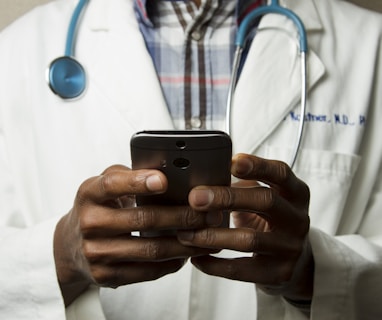Telemedicine's Tech-Driven Future: A Biomedical Engineering Perspective
Aditi Sharma
9/9/20232 min read


Imagine a world where you can consult with a healthcare professional, receive a diagnosis, and even undergo surgery, all without leaving the comfort of your home; a world where healthcare is not confined to the walls of a hospital or the boundaries of a clinic. Instead, it's delivered to you wherever you are, whenever you want. This futuristic vision is increasingly becoming a reality, thanks to the powerful partnership between telemedicine and biomedical engineering.
The Rise of Telemedicine: Telemedicine, often referred to as telehealth, is the remote delivery of healthcare services using technology. It encompasses everything from virtual consultations with healthcare providers to remote monitoring of patients' vital signs. Over the past decade, it has seen a spectacular rise, with its importance magnified during the COVID-19 pandemic. According to a report by McKinsey & Company, telehealth utilization surged from 11% of US consumers in 2019 to 46% in 2020.
The Biomedical Engineering Connection: At the heart of this telehealth revolution lies the dynamic field of biomedical engineering. These unsung heroes combine their expertise in engineering and biology to design the innovative technologies that make telemedicine possible.
Remote Monitoring Devices: Biomedical engineers have developed wearable and implantable devices equipped with sensors that collect real-time health data. Continuous glucose monitors help diabetic patients manage their condition, while smartwatches can monitor heart rate and detect anomalies.
Telehealth Platforms: The user-friendly telehealth platforms that connect patients and healthcare providers are the creations of biomedical engineers. These platforms enable video consultations, secure data exchange, and access to electronic health records, ensuring seamless remote care.
Medical Imaging and Diagnostics: Telemedicine often involves interpreting medical images such as X-rays, MRIs, and CT scans. Advanced imaging systems, designed by biomedical engineers, transmit high-quality images remotely, facilitating accurate diagnoses and treatment planning.
Robotic Telepresence: Beyond video consultations, biomedical engineers have designed tele-robots that enable physicians to "visit" patients in remote locations. These robots provide clinical assessments and even assist with surgeries.
Let's dive into some real-life examples showcasing the transformative impact of tech-driven telemedicine:
Remote Patient Monitoring: Wearable devices equipped with biomedical engineering innovations allow patients to track their vital signs, chronic conditions, and recovery progress from the comfort of their homes. This data is transmitted to healthcare providers in real-time, enabling early intervention when necessary.
Teleconsultations: Telemedicine connects patients in rural and underserved areas to specialist consultations without the need for time-consuming and costly travel. Patients can now discuss their concerns and receive expert guidance from the comfort of their homes.
Tele-stroke Programs: Telemedicine has been a game-changer in stroke care. Biomedical engineers have helped develop tele stroke programs that enable neurologists to assess stroke patients remotely. Timely interventions can significantly improve stroke outcomes.
Telesurgery: Biomedical engineers have worked on telesurgery systems that allow surgeons to perform procedures with the assistance of robotic technology, even when separated by great distances. This opens up possibilities for expert surgical care to reach remote or underserved areas.
The future of telemedicine is a tech-driven wonder, where healthcare knows no boundaries. Biomedical engineering serves as the driving force behind this transformation, making remote healthcare delivery possible through wearable devices, telehealth platforms, and advanced imaging systems. As telemedicine continues to evolve and overcome its challenges, it promises to revolutionize healthcare delivery, reducing disparities and improving patient outcomes. The fusion of telemedicine and biomedical engineering offers a glimpse into a future where healthcare is accessible, precise, and efficient for all, no matter where they are.
